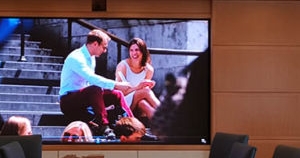LED display solutions have transformed the way large indoor and outdoor spaces communicate with their audiences. Still, perhaps influenced by smaller-scale applications of display technologies, many customers are more familiar with a substitute solution; namely, projectors. To help organizations decide which solution might be right for their space, let’s examine how the LED versus projection debate plays out in three particular areas.
LED Brightness Blows Projection Away
In spacious, open venues like a sports stadium, corporate lobby, or airport, the large audiences and ambient light levels present serious challenges for display technologies. Reaching these crowds and competing with surrounding natural and artificial lights is a task suited to only the brightest display solutions. A projector operating in a well-lit area will need to push their limits to shine with about 3,000 ANSI Lumens, the metric measuring reflected light. Since their light is direct, LED displays measure brightness with nits instead of ANSI lumens, and 3,000 ANSI Lumens translates to about 875 nits at a 3.426:1 ratio. What does that mean exactly? Well, if the equivalent of 875 nits is near the limits of projection technology, consider that Nanolumens LED solutions can sustain about 10,000 nits. Consider further that many projectors lose 30% of their brightness within their first year of use. These are among the reasons Cox Communications asked Nanolumens to replace their outdated projection technology with our LED solutions for their executive boardroom. Red Rock Resort asked us to do the same for their newly renovated sportsbook, where one of their integrators found that our screens “are literally operating at just 10% of their potential brightness and are already dramatically brighter than the projection video system they’re replacing.” In-home LED TVs are typically brighter than projectors. In commercial applications however, it’s not even a competition. LED wins out by a mile.
LED Size Measures Up –and Around
Projectors can create an image of almost any size, but they need a surface on which to project that image and an unimpeded space between the projector and the screen. Those constraints are more restrictive than what direct-view LED solutions require, which can integrate with little trouble working around low-hanging ceilings, rafters, or suspended fixtures. Nanolumens can create direct-view LED displays in any size, shape, or curvature that we’ve installed into floors, walls, and ceilings, and we’ve created tunnels and cylindrical halos as well. Projectors can create big images, but LED displays can create curved, angled, and versatile images that can immerse an audience without them getting in the way.
Cost Evolves Over Time to Advantage LED
A third differentiator between direct-view LED and projection is, of course, cost. In commercial settings, direct-view LED displays cost more at first, but make up for their higher initial costs with lower maintenance costs over time and less dramatic replacement needs in general. To repair a malfunctioning LED board, owners can simply swap in a new module at little to no cost. This takes mere minutes and most manufacturers will provide these spare parts upfront. Projection malfunction is often more serious and requires sending the projector back to the manufacturer for repairs. While replacing an LED board with a spare is immediate and nearly free, ordering a replacement projector bulb requires downtime from your display and can cost over $4,000 each time. On top of these complications, projectors use about twice as much power as LED displays do.
Each of these concerns indicates that in commercial settings a direct-view LED display is the right choice over a projector, without even mentioning the advantages LED displays hold with regard to longevity, color space, grayscale uniformity. If your organization is debating the merits of new display technologies, we suggest you start by looking at LED. Give us a call today and we can get you started!

